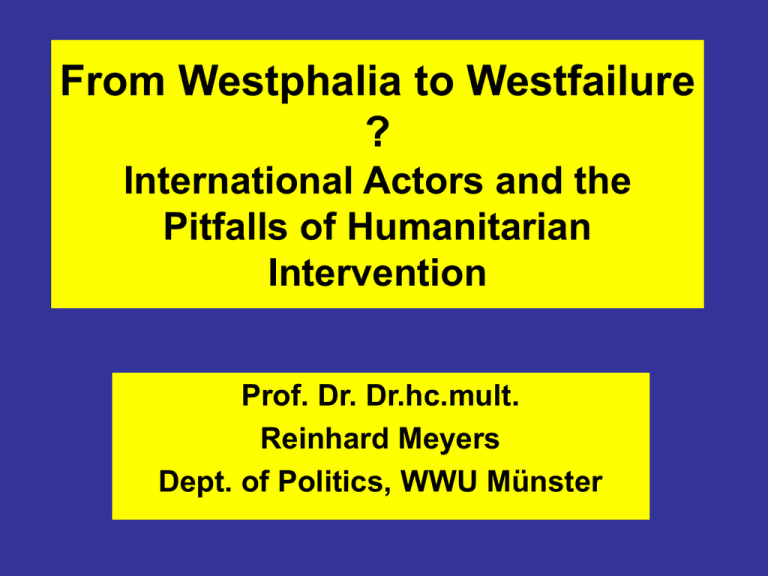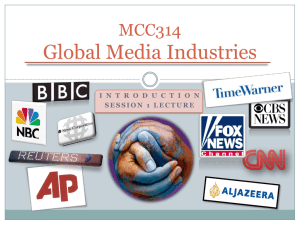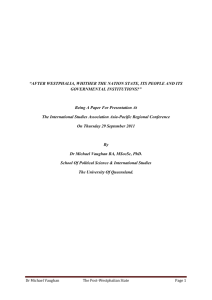From Westphalia to Westfailure - Prof. Dr. Dr. hc Reinhard Meyers
advertisement

From Westphalia to Westfailure ? International Actors and the Pitfalls of Humanitarian Intervention Prof. Dr. Dr.hc.mult. Reinhard Meyers Dept. of Politics, WWU Münster Acknowledgement • The title of this contribution is part-modelled on that of a very readable essay by Susan Strange: The Westfailure System, Review of International Studies 25 (1999), pp 345 – 354 • Susan, veteran battle-horse of British IR, widely learned, deeply human, died in 1998; thus, she could not fully witness what she predicted in two of her best books: • Casino Capitalism (1997) • Mad Money: when Markets Outgrow Governments (1998) This file can be downloaded from my website • http://reinhardmeyers.uni-muenster.de There you can also find further material to accompany our seminars on International Politics and War & Peace Lost in the maze ??? Send email to meyersr@uni-muenster.de Structure • I) The Westphalian State System – a metaphoric hyperbole ? • II) Cracks in the Monolith – Forces of Change • • • • a) Globalisation b) Globalisation of Threats c) Failing States d) New Wars • III) Some problems for Humanitarian Intervention • IV) Possible solutions I) The Westphalian State System – a metaphoric hyperbole ? • The overwhelming majority of I.R. writers posit a truism – i.e. that the Peace of Westphalia • made the territorial state the cornerstone of the modern state system (H.J.Morgenthau) • formally recognized the concept of state sovereignty (M.Sheehan) • formally acknowledged a system of sovereign states (H.Spruyt) • established a number of important principles, which were subsequently to form the legal and political framework of modern interstate relations (Evans & Newnham) Westphalian State System (II) • In short, the system so mentally constructed can be briefly defined (remembering Max Weber‘s famous definition of the state) as one in which prime political authority is conceded to those actors called states, claiming the monopoly of legitimate use of violence within their respective territorial borders, resting on mutual restraint (i.e. nonintervention) and mutual recognition of each other‘s sovereignty. Westphalian State System (III) • The perception of international order thus established rested on five pillars: • 1)National actors are the sole holders of sovereignty • 2) Sovereignty is exercised over physical territory • 3) National actors are the most powerful players of the world system • 4) The only enforceable international law is based on treaties between sovereign actors • 5) War is a legitimate instrument of international politics The Billiard-Ball-Model of international Politics Attracting forces Repellent forces Westphalian Realism: Characteristics • The structure of the international system is anarchic. There is no authority above states capable of regulating their interactions; states must arrive at relations with other states on their own, rather than being dictated to by some higher controlling entity. • Sovereign states are the principal actors in the international system. International institutions, nongovernmental organizations, multinational corporations, individuals and other sub-state or trans-state actors are viewed as having little independent international influence. • States are rational unitary actors each moving towards their own national interest. They distrust long-term cooperation or alliance. …in brief… The traditional concept of international politics: • States as international gatekeepers • holding the monopoly of the legitimate use of armed power in a given territory • playing a zero-sum game for power, influence, ressources, territory in the international system IGO = government State C = society Society C State A State B Society B Society A INGO = foreign or international societal interactions = foreign or international political interactions Westphalia: Critique • More recent historiography (e.g.A.Osiander) has identified the Westphalian system as a mental construct - „…a figment of nineteenth-century imagination, stylized still further, and reified, by the discipline of IR itself in the twentieth century…“ (2001:284). • The point is well worth debating, and would provide ample ground for a number of (de-) constructivist PhD theses. • However, for my present purposes I would like to draw your attention to a different train of arguments: LOOKING AT THE INTERNATIONAL SYSTEM FROM A RECENT INTERNATIONAL RELATIONS PERSPECTIVE For some time already, the analysis of International Relations is characterised by a change in perspective - away from the state as a unitary actor acting as a gatekeeper between the domestic and international policy areas - up, down, and sideways to supra-state, sub-state, and nonstate actors. From the society of states, our focus of attention has consequently shifted to transnational and transgovernmental societies which take the form of boundary-crossing networks amongst individuals and non-governmental organisations (NGOs). Transnational Society (of Actors) Government Government Government Transnational Society A Society National Actor B Society C Society Transnational Politics Government A Society Government B Society Government C Society Cobweb model of international Relations International flight connections, 2010 II Cracks in the Monolith – Forces of Change • No doubt, this change of perspective just mentioned resulted from the very real changes of the international system which on the one hand caused, and on the other were driven by Globalization – the globalization of chances as well as the globalization of threats, IIa Globalisation “…in its simplest sense globalization refers to the widening, deepening and speeding up of global interconnectedness…” Held, McGrew, Goldblatt, and Perraton, 1999. Global Transformations: Politics, Economics and Culture Victory of time over space ”A sense of the shrinking of distances through the dramatic reduction in the time taken, either physically (for instance via air travel) or representationally (via the transmission of electronically mediated information and images), to cross them.” (Tomlinson, J.: Globalization and Culture,1999, p.3) 20 …two of the consequences… • Dematerialization of economic and particularly financial processes • Denationalisation of firms/international business actors Globalisation: Driving Forces & Challenges Technological Change Economic Globalisation Liberalisation/Deregulati on Political Liberalisation Territorial Asymmetry Temporal Asymmetry Legitimacy Deficit Complexity Asymmetry of Norms Operationa l Deficit Asymmetry of Actors 22 Globalisation: Problems IIb Globalisation of Threats – or Westfailure • It is Susan Strange‘s argument that the Westphalia system grew up in a close relationship with the capitalist market economy prevailing in Europe, from the early modern period onward. Each was a necessary condition for the evolution of the other. To prosper, production and trade required the security provided by the state. To survive, the state required the economic growth, and the credit-creating system of finance provided by the capitalist system. Westfailure (2) • The development of the economic system, by now, has created three major problems that the political system is incapable of solving: • 1) The major failure to control and manage the international fnancial system • 2) The failure to act for the protection of the environment • 3) The failure to preserve a socio-economic balance between the rich and the powerful and the poor and the weak both nationally and internationally Westfailure (3) • „ In short, the system is failing Nature – the planet Earth – which is being increasingly pillaged, perverted, and polluted by economic enterprises which the state-system is unable to control or restrain. It is failing Capitalism in that the national and international institutions that are supposed to manage financial markets are progressively unable … to keep up with the accelerating pace of technological change in the private sector, with potentially dire consequences for the whole market economy. And it is failing world society by allowing a dangerously wide gap to develop between the rich and powerful and the weak and powerless.“ (p.346) IIc Asymmetric Warfare New Wars • Reference to Mary Kaldor: New and Old Wars: Organized violence in a global era, ²2006 • Questioning of the state as the war and violence monopolist • Asymmetric structure: regulars fighting irregulars • Spatial & temporal de-limitation • Privatisation/commercialization of violence New Wars (2) • Goals: identity-political rather than geopolitical or ideological • Autonomization/independency of traditional military actors & traditional military forms • Glocalization of warfare • Concurrence of the non-concurrent: decentralization and informalization of the (local) war economy (suffering from deinvestment spiral) with simultaneous interlocking and interweaving with a global shadow economy IId Failing States • A state that is failing has several attributes. One of the most common is the loss of physical control of its territory or a monopoly on the legitimate use of force. • Other attributes of state failure include the erosion of legitimate authority to make collective decisions, an inability to provide reasonable public services, and the inability to interact with other states as a full member of the international community. Failing States (2) • Further indicators cover a wide range of state failure risk elements such as extensive corruption and criminal behavior, inability to collect taxes or otherwise draw on citizen support, large-scale involuntary dislocation of the population, sharp economic decline, group-based inequality, institutionalized persecution or discrimination, severe demographic pressures, brain drain, and environmental decay. • States can fail at varying rates through explosion, implosion, erosion, or invasion over different time periods. http://www.fundforpeace.org/global/?q=fs for the Failed States Index – yearly tables & maps III Some Problems and Pitfalls for Humanitarian Intervention • The Westphalian system, as we have seen, does no longer provide a clear frame of reference regarding • - the proper motives to act • - the proper agenda to act on • - the proper point in time to start action • - the criteria to assess success or failure • - and, most importantly, the other actors and/or third parties to address legitimately. …Problems & Pitfalls (2)… • What weighs perhaps most is the fact that the concepts of peace I.R. and/or Int. Law can offer are in essence those of the Westphalian system – • peace as a systemic condition of the system of states, • a pattern governing inter-state behaviour, • or quite simply as the absence of the application of organized military force between large social groups. • All these concepts do not fit the fuzzyness, de-structurization, glocalization, anti-state-monopolistic privatisation of violence which seems to be the main characteristic of post-Westphalian politics. …Problems & pitfalls (3)… • We need, in other words, a new, adequate, sustainable concept of peace which reflects the changes from Westphalia to postWestphalia. • A start has been made – nearly 20 years ago – with the Agenda for Peace. • Preventive diplomacy, peacemaking, and peacekeeping could furnish the new pillars of the post-Westphalian system. • The task, as the next graph shows, is however extensive and daunting. Nachhaltiger Friede • Gewaltfreiheit • Selbsterhaltung • Innere/Äussere Legitimation • Konstruktive Konfliktransformation Mediation, Verhandlung, Schlichtung, • politische Demokratisierung Änderung des moralischpolitischen Klimas • Wirtschaftl. Wiederaufbau • Wiederherstellung des Rechtsstaats Verheilung der Wunden der Vergangenheit • Erziehung und Ausbildung, Gesundheitswesen/-vorsorge Ökologisches Gleichgewicht Streitbegleitung Versöhnung Wiederaufbau PRÄVENTION (Reconstruction) Engagement für die Zukunft Versöhnung der Werte Entwicklung eines WirGefühls und multipler Loyalitäten Versöhnung (Reconciliation) Friedensschaffung (Peace Building) Sicherheit Rüstungskontrolle Abrüstung Friedenswahrung (robustes) Peace Keeping Thank You for your patience…









